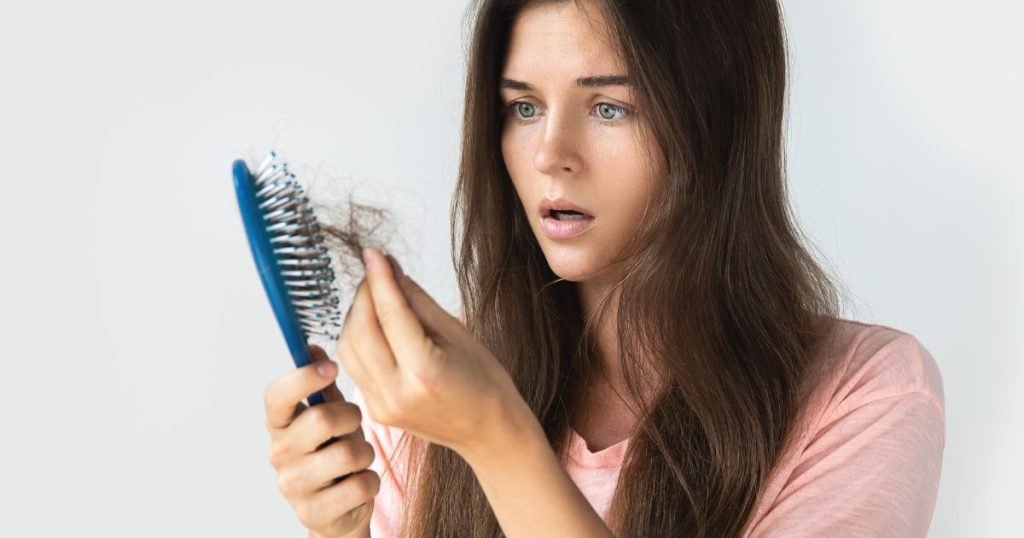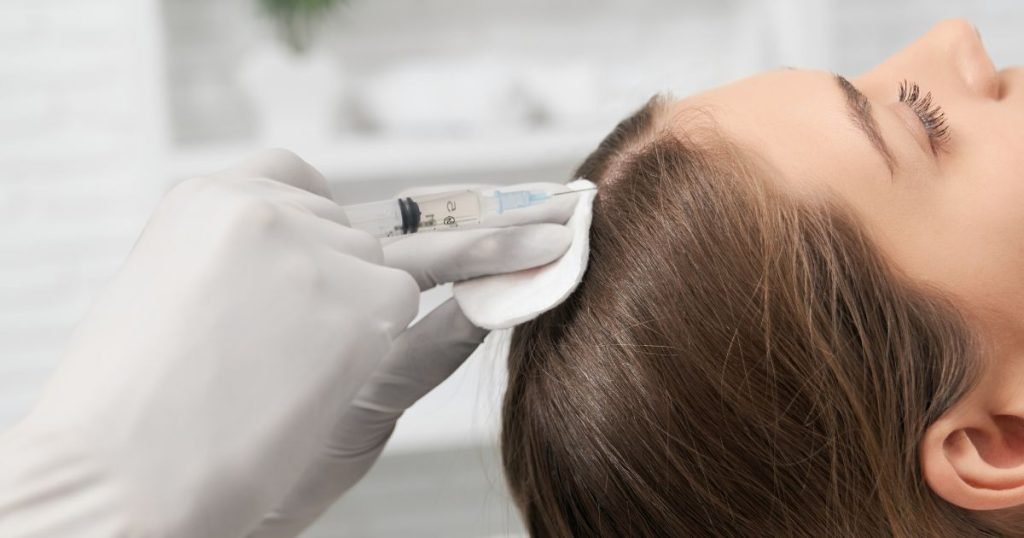Female pattern hair loss is a common condition that affects millions of women worldwide. It can be difficult to cope with this condition’s physical and emotional effects, especially if it has occurred for some time.
Fortunately, treatments may help reverse female pattern hair loss in many cases. This article will discuss the current research on whether or not female pattern hair loss is reversible and potential treatment options.
Female pattern hair loss typically occurs due to hormonal imbalances caused by genetics, age, menopause, pregnancy, or certain medications. This type of hair loss usually presents as thinning at the top and crown of the head.
While there is no cure for female pattern hair loss, studies have suggested that certain treatments may help slow down its progression and even partially reverse it in some cases.
Understanding Female Pattern Hair Loss
Hair loss is a common issue for many people, especially women. Female pattern hair loss (FPHL), known as androgenetic alopecia, affects 40 million American women today.
It’s characterized by thinning the hairs on your scalp in a predictable pattern — usually a widening part line or diffuse reduction in density over the top of the head. As with male baldness, it’s caused by sensitivity to androgens like testosterone that causes follicles to miniaturize until they can no longer produce full-sized hairs.
The female pattern hair loss is reversible; however, treatment options vary depending on the cause, age, and lifestyle factors. Early prevention is key to reversing FPHL, so if you notice any signs of thinning or receding hairlines, it’s best to speak with a doctor immediately.
Treatment may include medications such as topical minoxidil solution, which helps stimulate new growth, or oral finasteride, which reduces DHT levels, thereby stopping further hair loss from occurring. Lifestyle changes such as reducing stress levels and having balanced nutrition are important steps toward helping restore lost locks since these activities can help reduce inflammation and improve blood circulation throughout the body.
Common Causes Of Balding
Female pattern hair loss can be a devastating experience for many women. While it may feel like there is no hope, the good news is that this balding is often reversible with proper treatment.
The underlying cause of female pattern hair loss is hormonal imbalances, specifically androgenic alopecia.
To determine if you are suffering from this condition, your doctor will likely evaluate your scalp and take blood tests to measure hormone levels in your body.
Depending on the results, they may prescribe medications or suggest other treatments, such as hair transplants or topical solutions.
No matter what action you choose, don’t despair – options are available to help regain your desired healthy head of hair!

Diagnosis And Early Detection
When diagnosing female pattern baldness, a medical professional will consider several factors. This includes the patient’s medical history and any family history of hair loss or an autoimmune condition. A physical examination may also be performed to check for signs of inflammation in the scalp area.
A trial treatment period may be recommended depending on the severity of the symptoms and individual cases. During this trial period, doctors can monitor the effectiveness of medications, lifestyle changes, or other treatments to reverse female pattern hair loss.
After the trial period, additional treatments may need to be discussed if further improvement is desired.
Following ongoing monitoring with their doctor, many women have experienced successful results from reversible female pattern hair loss treatments.
Reversing Female Pattern Hair Loss
Up to one-third of women will experience female pattern hair loss (FPHL) at some point. Although this issue can be quite distressing for many, understanding the causes and treatments available may help women find ways to reverse the condition.
FPHL is a type of balding that occurs when certain hormones cause hairs on the scalp to shrink or become thinner over time. This gradual thinning typically follows a distinctive pattern; it usually starts with a widening part line or receding hairline and progresses backward toward the crown of the head.
Fortunately, several treatment options are designed to help women manage their FPHL. Topical medications such as minoxidil, which helps promote hair growth by increasing blood flow to the scalp, are effective in reversing FPHL if used regularly and consistently over time. Hair transplant surgery is one of the options for those who want more dramatic results; however, its cost may not make it feasible for everyone.
Lifestyle changes like a healthy diet full of protein and vitamins for proper hair health can help reduce symptoms associated with FPHL. Various approaches are available for treating female pattern hair loss, from exploring different options to managing hormone levels through medication.
It’s important for women experiencing this problem to consult a healthcare professional about what might work best for them based on their needs and preferences before beginning any treatment plan.
Hair Growth Science
Female pattern hair loss is a common disorder that affects many women and can be reversed with proper treatment. It occurs when the androgen hormones cause hair follicles to shrink, resulting in thinning or balding of the scalp.
Understanding how hair growth works is the most important factor for reversing female pattern hair loss. Hair growth has three phases – anagen (growth), catagen (transition), and telogen (rest). During anagen, which typically lasts two to six years, new hairs are produced as the old ones shed. By stimulating the anagen phase through treatments like minoxidil solutions or laser therapy, it’s possible to reverse female pattern hair loss by encouraging healthy regrowth of lost strands.
Aside from medical therapies, lifestyle modifications may also aid in reversing female pattern hair loss. Eating a balanced diet rich in proteins and vitamins can help promote healthier, thicker-looking locks while limiting stress levels helps keep hormones at bay. Regular exercise encourages better blood circulation throughout the body, including to the scalp, where increased oxygenation can improve the overall health of existing strands and stimulate new growth.
In addition, avoiding harsh chemicals such as bleaches on your tresses keeps them looking shiny and vibrant over time. Taking these steps together can drastically reduce symptoms associated with female pattern hair loss while helping encourage effective reversal over time.
Hormonal Changes And Hair Loss
Hair loss is a condition that has personally affected many women and can be associated with drastic physiological changes. Though female pattern baldness is often considered irreversible, hormonal alterations in the body and low-level laser therapy may offer hope to those who feel hopeless against this affliction.
Androgens, hormones present both in men and women but predominantly found in males, are known to affect hair growth cycles. When levels of these hormones increase due to lifestyle factors or genetics, they can cause increased shedding of hair follicles along with a decrease in regrowth capabilities. Both symptoms are closely linked to female-pattern baldness.
For some people, decreasing the production of androgens through medication or altering their diet can reduce the amount of hair loss significantly; however, this option may not work for everyone.
Low-level laser therapy (LLLT) is another potential solution that involves shining light directly onto the scalp, which stimulates follicle cells and encourages new strands of healthy hair to grow in place of thinning patches. While more research needs to be done on its efficacy before it becomes widely accepted among medical professionals, LLLT has successfully reversed hair loss for some individuals when used correctly.
Genetic Factors And Hair Loss
Genetic factors are important in female pattern hair loss and its reversal. A genetic predisposition to balding can increase the risk of experiencing hair loss, so it is important for those struggling with this condition to understand their family history.
Genetics may also influence how a person responds to certain treatments, such as finasteride.
Hair cycling — the process by which new hairs replace old ones — is another factor that differs between individuals due to genetic traits. Those with genes that cause shorter cycles are more likely to experience hair thinning or loss sooner than those with longer cycles, making them ideal candidates for finasteride treatment.
It’s worth noting that although genetics may be a contributing factor when it comes to pattern hair loss, other lifestyle elements like diet and hormones should still be taken into consideration when attempting to reverse this condition.
Lifestyle Habits And Hair Loss
Female pattern hair loss can be reversible, depending on the condition’s underlying cause. For example, a study was conducted on two women with thin hair due to alopecia areata and cicatricial alopecia. After following certain lifestyle habits such as reducing stress levels, using natural oils for scalp treatment, and avoiding hairstyles that pull at their hair, both women experienced a significant reduction in bald patches or thinning hair.
To address female pattern hair loss effectively, it is important to:
- Avoid any tight hairstyles, including braids and hair extensions;
- Use gentle products when washing your hair without harsh chemicals;
- Minimise stress by incorporating activities like yoga and meditation into your daily routine;
- Seek medical advice if you notice sudden changes in the texture or amount of your hair or develop bald spots or patches.

By taking these steps, you may be able to reverse some symptoms associated with female pattern hair loss in some cases. However, further investigation into the cause of this type of alopecia should still be done to ensure an accurate diagnosis and appropriate treatment plan can be established.
Treating Female Pattern Hair Loss With Medication
Female pattern hair loss (FPHL) is a type of hair loss that affects many women. It can be hereditary or caused by other factors, such as hormonal changes in postmenopausal women.
Treating female pattern hair loss includes medications and topical minoxidil solutions. Oral contraceptives may help to reverse the effects of FPHL. Other treatments include finasteride tablets for men and spironolactone for pre-menopausal women. Topical minoxidil solutions are also used to stimulate hair growth in those with FPHL but should only be used under the direction of a healthcare professional.

In some severe cases, medical intervention, such as hair transplantation or scalp reduction surgery, may be necessary. These treatments have proven effective at reversing the symptoms of FPHL; however, it’s important to note that any treatment plan should only be taken on after discussing all options with a doctor.
With proper care and attention to treating female pattern hair loss, significant improvement can often be seen over time.
Topical Solutions For Hair Loss
Surprisingly, female pattern hair loss is not always permanent. In the United States alone, approximately 30 million women experience some degree of this condition. With advances in medical treatments and topical solutions for hair loss, reversing or halting further progression of hair loss is possible.
When considering treatment options for female pattern hair loss, a doctor will assess the presence of any underlying conditions that may be contributing to the issue. This assessment helps guide a healthcare provider in determining if medications can help stimulate new growth on the scalp and restore normal hormone balance within the body. Additionally, they may suggest lifestyle changes such as stress reduction techniques and dietary modifications, which could improve overall health and reduce symptoms associated with hair thinning or shedding.
In addition to medical interventions, several cosmetic procedures are available to help thicken existing strands of hair or cover noticeable patches of baldness. Hair transplants involve surgically moving healthy donor follicles from one area of the head to another where bald spots exist; it’s important to note that these typically require multiple sessions over time before achieving desired results.
Various topical solutions on the market are designed to strengthen weakened areas along each individual’s hair shaft while stimulating regrowth at the cellular level. Finding an effective solution requires patience and commitment but can bring back much-needed confidence when successful.
Laser Therapy And Female Pattern Hair Loss
Female pattern hair loss (FPHL) is a common condition that affects many women and can cause distress due to the physical effects. Laser therapy has recently been proposed as a potential treatment for FPHL, with its effectiveness depending on the stage of hair loss.
Laser therapy reduces androgen activity in the scalp, which helps improve hair growth in those affected by FPHL. It may also be combined with cognitive-behavioral therapy and topical minoxidil therapy for optimal results.
Studies have shown laser therapy to be effective in improving hair density, thickness, quality, and overall appearance of scalp hair in those who suffer from this condition. In addition to reducing androgen activity, laser therapy has also been found to reduce inflammation associated with follicular miniaturization in patients with FPHL.
This helps promote healthy hair regrowth while slowing down the progression of further thinning or balding. Furthermore, it is a safe and noninvasive procedure requiring no downtime after completed treatments.
Therefore, laser therapy is an effective option for managing female pattern hair loss symptoms without significant risk or side effects. Proper use can help slow down the rate of shedding while stimulating new growth over time.
Mesotherapy And Female Pattern Hair Loss
Moving on from laser therapy, mesotherapy is another potential treatment for female pattern hair loss. This technique involves the introduction of vitamins, minerals, and other active elements directly into the scalp to help restore hair growth. It is thought that administering these substances locally can directly reduce androgen levels and stimulate new hair growth within the affected area.
Mesotherapy offers several advantages when treating female pattern hair loss:
- It helps to reduce stress hormones which contribute to hair loss;
- It can improve circulation in the scalp, encouraging healthy follicles;
- And it may be able to kick-start dormant hairs back into their natural growth cycle.
Although limited research has been conducted regarding using mesotherapy as an effective treatment for female pattern hair loss reversal, some studies suggest this alternative approach could be beneficial in targeting specific areas of thinning or baldness due to its ability to deliver precise amounts of medication into particular regions of the scalp.
Further clinical trials are needed before definitive conclusions can be made about its long-term effectiveness.
Platelet-Rich Plasma Therapy And Hair Loss
Platelet-rich plasma (PRP) therapy is a promising treatment option for pattern hair loss patients. It involves taking the patient’s blood and separating out the platelets, which are then injected into thinning or balding scalp areas. The platelets contain growth factors that stimulate new hair follicle development and promote existing hair regrowth.
Studies have shown PRP to be an effective treatment for hair loss due to its ability to improve density, texture, and coverage in both men and women with pattern hair loss.
In one study involving 20 female patients undergoing six treatments of PRP over 12 months, it was observed that there was a significant improvement in overall hair density, thickness, and quality when compared to baseline measurements at 18 months post-treatment. Furthermore, approximately 70% of participants reported improved satisfaction with their appearance after receiving this novel treatment.
These results indicate that PRP is a safe and effective way to manage pattern hair loss for both men and women. With continued research into this approach’s efficacy and other treatments available for treating pattern hair loss, we may soon find more ways to help individuals successfully reverse their condition and regain confidence in their natural beauty without resorting to more invasive options like wigs or medications.

Hair Transplantation And Female Pattern Hair Loss
Hair transplantation is a popular option for treating female pattern baldness. It involves surgically removing hairs from one area of the scalp and relocating them to thinning or balding areas. This procedure can be done in different ways, such as strip harvesting, follicular unit extraction (FUE), and scalp reduction surgery.
The benefits of hair transplantation include the following:
- Improvement in both appearance and confidence due to the natural-looking results
- Permanent solution with no long-term side effects
- Minimal scarring or visible signs of trauma left behind after the procedure
In addition to hair transplantation, other treatments are available for female pattern baldness, including topical medications, laser therapy, dietary supplements, and hair-building fibers.
Central centrifugal cicatricial alopecia (CCCA) is a type of permanent hair loss seen more commonly in African American women where treatment options may not always be successful. Regardless of the cause of your condition and what treatment you choose ultimately depends on individual factors like age, sex, genetics, lifestyle habits, etc.
A Multi-Pronged Approach To Hair Restoration
It is encouraging to know that female pattern hair loss can be reversible with a multi-pronged approach.
Hair transplantation and medical treatments such as drug therapy, hormone replacement, or dietary changes are some of the most common options for reversing this condition.
Additionally, behavioral therapies like stress management and lifestyle modifications may help reduce symptoms and restore thinning locks.
All of these approaches must be tailored according to individual needs and preferences so that they reach their full potential.
Furthermore, support from family members, friends, colleagues, and mental health professionals should not be overlooked as part of the treatment plan.
With the right combination of treatments, women hope to regain healthy tresses.
Hair Care Tips For Women With Hair Loss
Patients experiencing female pattern hair loss are encouraged to take extra care of their hair. This includes avoiding over-brushing and chemical treatments and not using too many styling products such as hair sprays or mousses.
To further protect the existing strands of healthy hair, it is important to use a shampoo specifically formulated for those with thinning hair. Additionally, patients should keep their head hair hydrated by applying conditioner after each wash.
It’s also recommended that they avoid hot tools like curling irons and straighteners if possible to prevent any potential heat damage. These steps can help maintain a healthy head of hair and potentially reverse the effects of female pattern baldness.
Nutrition And Hair Health
Hair is like a plant; it needs nourishment to grow and stay healthy.
When it comes to female pattern hair loss, proper nutrition can be key when attempting to reverse the effects of this condition.
Hair health depends on an adequate intake of vitamins and minerals, especially those known to counterbalance the action of androgens in women with this type of hair loss.
Those dealing with female pattern hair loss must maintain a balanced diet of nutrient-rich foods such as fruits and vegetables, whole grains, lean proteins, legumes, nuts, seeds, fish oil supplements, and other omega-3 fatty acids.
Additionally, heeding advice from healthcare professionals regarding appropriate supplementation may help address deficiencies or imbalances identified by careful examination and evaluation.
With these essential elements incorporated into one’s daily routine, there is potential for positive change in reversing female pattern hair loss.

Celebrating Female Hair Diversity
The nutritional needs of women with female pattern hair loss, or androgenetic alopecia, vary from those who suffer from diffuse alopecia. Eating a well-balanced diet rich in proteins, fats, vitamins, and minerals can help slow the progression of female pattern hair loss as it is closely linked to genetic factors triggered by certain hormones.
When considering treatment options for female pattern hair loss, clinicians should consider other non-surgical treatments, such as traction alopecia or transplantation in women. The effectiveness of these treatments depends on how advanced the condition is and whether there is an underlying hormonal imbalance within the body.
Androgen receptors play a key role in regulating scalp hair growth; therefore, treating any existing imbalances could potentially reverse some of the effects of female pattern hair loss.
It’s important to recognize that all types of hair have their own unique beauty – celebrating this diversity helps us see beyond stereotypes and understand our individual differences more deeply by creating a space where we honor different kinds of beauty rather than one idealistic view of what “beautiful” looks like we can build greater self-confidence and ultimately promote healthier hairstyles habits amongst individuals suffering from female pattern baldness.
Alternative Treatments For Female Pattern Hair Loss
The sight of thinning hair and bald patches can be heartbreaking for any woman. Female pattern hair loss is one of the common problems affecting millions of women, causing diffuse hair loss on the scalp and leaving them unsightly.
But there is hope – female pattern hair loss is reversible in many cases! Various treatments are available to help reverse female pattern hair loss and restore fuller, healthier-looking hair.
Antiandrogen drugs such as finasteride can sometimes reduce the shedding rate and encourage regrowth. Other treatment options include topical minoxidil or laser therapy, which stimulates follicles to produce thicker hair strands over time.
Combining these treatments may offer the best chance of restoring patterned locks back to their former glory! Regardless of your approach, it’s important to remember that reversing female pattern hair loss takes time and patience.
Follow your doctor’s advice carefully to maximize results from your chosen treatment plan and stay positive throughout the process – you will soon see the fruits of your labor in terms of voluminous, healthy-looking locks.
Coping With Hair Loss Emotionally
The psychological effects of hair loss can be just as devastating for women, especially those dealing with female pattern hair loss. Hair diseases like this are still poorly understood, and managing hair loss can be difficult to navigate.
The reduction in hair density due to advanced hair loss may cause embarrassment, depression, or distress that affects a woman’s daily life, interpersonal relationships, and self-confidence.
To cope emotionally with female pattern baldness reversal, it is essential to find strategies considering the individual’s physical and mental needs. Developing coping mechanisms such as positive thinking techniques, exercise, and mindfulness activities is important, which helps build confidence and reduce stress levels.
Patients should also consider seeking professional help if needed to better manage their emotions related to their condition. Additionally, regular visits with a physician specializing in trichology (the scientific study of scalp health) can help provide insight into how best to address the patient’s specific case.
Conclusion
It is important to remember that female pattern hair loss can be reversible. While it may seem overwhelming, understanding the causes and available treatments can make a difference in coping with this condition.
As discussed throughout this article, numerous options exist for reversing or slowing down female pattern hair loss. Everyone has different needs for treating hair loss, from lifestyle changes such as eating nutritious foods and managing stress levels to medical solutions like minoxidil or PRP therapy.
Many women have significantly improved their hair health and growth by turning these treatment plans into habits.
Overall, while female pattern hair loss can be a difficult experience emotionally, it does not need to define who you are. With the right help and support from professionals, friends, family members, and even yourself, you can take control of your journey toward restoring beautiful, healthy locks!
Like a phoenix rising from the ashes, your hair can rise above its former state of balding and emerge stronger than ever before.

I don’t think the title of your article matches the content lol. Just kidding, mainly because I had some doubts after reading the article. https://accounts.binance.com/pl/register?ref=YY80CKRN